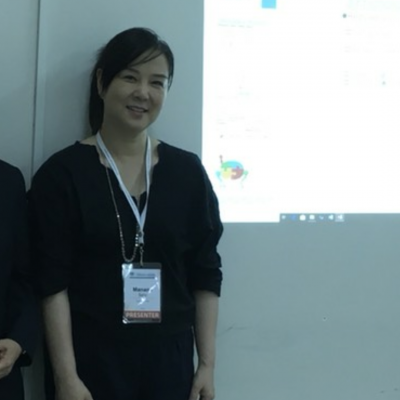Sessions / College and University
Incorporating AI into two Extensive Reading programs #4107
This presentation will introduce ER programs at two separate universities, one incorporating xreading and another utilizing physical books, and will review the activities in both programs. After reviewing these two programs and their implementation, I will discuss how AI has been incorporated in the form of Google NotebookLM to support extensive reading. Google NotebookLM, is a Google AI-powered tool that helps users interact with documents and sources by summarizing, extracting information, and answering questions based on uploaded content. NotebookLM’s ability to generate audio summaries has the potential to enhance ER by improving comprehension and engagement. Surveys and semi-structured interviews with students will be presented to reveal student impressions of the tool. This presentation will then discuss how NotebookLM can be integrated into an ER program, as well as its benefits, challenges, and pedagogical implications, with the aim of offering insights into AI’s role in supporting extensive reading.
Implementing ER through XReading: Perceptions, Benefits and Challenges #4393
This presentation reports the preliminary results of an extensive reading (ER) program implemented using XReading, a subscription-based virtual library. Thirty-two students participated in a 9-week study as part of a college General English course in Taiwan. Using data from post-program questionnaires and focus group interviews, the study explores learners’ perceptions of XReading for ER and investigates ER’s impact on their attitudes towards reading in English, and perceived benefits and challenges. The study reveals that most participants responded positively to using XReading for the ER program. The findings indicate that learners generally perceived improvement in their overall reading ability, reading rate, vocabulary, and motivation to learn English. However, many failed to meet the reading goal due to time constraints, lack of interest, or selecting readers that were either too challenging or not to their preferences. Recommendations to enhance participation and guidance are discussed for better implementation of online ER programs.
The Five-Finger Rule in Action: Do Thai EFL Learners Really Use It? #4246
The Five-Finger Rule is a widely recommended strategy for selecting appropriate reading materials in Extensive Reading (ER) programs, particularly for language learners using graded readers. This study investigates how Thai university students apply and perceive the rule, and how they implement it, using an online survey to collect data from 64 students participating in an ER program. Data on the number of books they assessed, the number of difficult words they encountered, and their reasons for choosing a particular book were gathered. The findings revealed that most students (53.8%) selected books that fell within the recommended difficulty range, aligning with their goal of a moderate challenge that still allows for comprehension. Interestingly, 13.8% of students intentionally chose books at a higher difficulty level, motivated by a desire to expand their vocabulary. These findings suggest that students adapt the Five-Finger Rule based on personal reading goals and language learning strategies.
Dictionary Usage during Extensive Reading #4063
It is often recommended that learners not use a dictionary when doing Extensive Reading and instead rely on surrounding context to infer meaning of unknown words. The current research project, supported by a Japanese federal grant, is investigating how access to an integrated dictionary during ER correlates with learners’ ability to accurately guess meaning. Roughly 120 first-year English majors read 200-300,000 words using the ER application Xreading, which offers optional access to glossary definitions. At the beginning and end of the year, students report the reading strategies they use and take a test to gauge their ability to accurately guess meaning from context. This presentation will report results from the first three years of the research project. Results thus far do not indicate overall significant differences between control groups and those allowed dictionary access. Later stages of this research will include further replication and the addition of guessing from context training.
Embedding ER as Core Content in LMS CollegePathway and Academic Express 3 #4470
CollegePathway and Academic Express 3 are LMS platforms built on supereigo.com that support multiple English learning goals including TOEIC, EIKEN and university entrance exams. They are used by over 100 institutions across Japan and serve hundreds of thousands of students and teachers. In April 2025, we added Pearson Bank, a repository of 30 graded short stories ranging from abridged classics to original Pearson titles. Each story is accompanied by in platform vocabulary, grammar and comprehension exercises so that extensive reading becomes part of both the student learning experience and the teacher toolkit. This presentation describes the integration process including curriculum alignment and workflow embedding. We examine three months of log data to understand how teachers and students incorporate story reading and how story use aligns with overall platform engagement. This case offers a scalable model for embedding graded extensive reading as a central measurable component of language learning on large scale digital platforms.
Extensive Reading and Media Representation in Discourse Analysis #4239
Considering the significance of critical thinking skills in Discourse Analysis, this study explores the effectiveness of reading, particularly in analyzing the representation of the former Indonesian President Joko Widodo. Before engaging in discussion and paper writing, 20 sixth-semester intermediate English students read two 1,000-word newspaper articles weekly for five weeks on post-presidency activities. This task aims to enhance their critical reading skills, expose them to varied discourse strategies, and provide a rich foundation for discussion. After the discussion, students complete a questionnaire assessing the impact of reading on analytical engagement and discourse comprehension. Preliminary findings suggest that the task aids in identifying linguistic patterns, contextual influences, and ideological framing in media texts, leading to more nuanced discussions and deeper analytical insights. Utilizing a qualitative research method, this study highlights the role of reading in fostering critical thinking and discourse competence, reinforcing its value as a pedagogical tool in discourse analysis courses.
Effect of Long-term ER on Productive Knowledge of High-Frequency Vocabulary #4030
Incidental vocabulary learning through ER has been examined for the uptake rate of new words learned, but ER also provides an opportunity to deepen knowledge of high-frequency words. This study examines the productive knowledge of high-frequency English vocabulary of Japanese university students of similar English proficiencies between those who have read over 430,000 tokens of ER and those with little or no ER experience. Subjects were tested on receptive and productive knowledge of the 2000 most frequent words of the NGSL (New General Service List) utilizing the testing application VocabLevelTest (McLean & Raine, 2019). ANOVA results showed a significant main effect of ER on productive vocabulary (p < .001, η² = .32), with similar effects observed for both NGSL 1-1000 and NGSL 1001-2000 word bands. These results suggest that ER contributes to strengthening productive knowledge of high-frequency words through repeated encounters in meaningful contexts, additional justification for curriculum integration of ER.
Student Engagement with Free Chosen and Assigned Books in an ER Course #4071
This study investigated an Extensive Reading (ER) implementation in a university classroom. It involved the first-semester students who read a combination of the same graded readers at different levels and self-selected books based on their preferences. The study focused on students' engagement and progress on the combination as well as on group dynamics in the classroom. The data collection included students’ reading logs, group work results, and students’ feedback. By analyzing student feedback and individual and group reading engagement data, the study found that most students participated in the group reading and enjoyed the combination of two types of book choices. However, some challenges such as book availability, demotivated students, and students’ reading speed were still present.
A Post-Graded Reader Wasteland? Issues, Tools, and Solutions for Japanese #4085
L2 English learners have been blessed with a wealth of research and resources to address various issues in reading comprehension and fluency development, but the same level of attention has not been paid to the issue of “laddering up” to independent reading in other languages. For Japanese, there is the additional barrier of kanji on top of the potential barriers to reading texts written for L1 speakers such as vocabulary, grammar and cultural knowledge. This presentation will discuss these issues as well as introducing some of the available tools and potential solutions that can assist learners to reach independent reading, such as the use of Aozora Bunko and the JLEX lexical analyser. In particular, it will focus on fostering learner reading outside of the classroom, given that the large volumes of text required to achieve independent reading are best done outside of class hours, with some in-class support.
The Hobbit as a Paradigm for Teaching Literature to 21st Century SLA Students #4109
A partnership between The Hobbit and technology can help overcome the challenge of teaching SLA literature in the 21st century. The development of extensive reading habits is an ongoing challenge for SLA students. Tolkien wrote this work for his children in a way that helps instructors and students meet that challenge. Simple vocabulary and syntax, identifiable characters, a mythic structure at once familiar and new, and popularity that has resulted in translation into over 60 languages all combine to make The Hobbit a broadly applicable tool in SLA extensive reading instruction. This presentation illustrates the scaffolding methods, syllabus design, online journaling, AI interaction, and evaluation techniques of an upper-level CLIL literature course using the annotated version of The Hobbit as instructional material. The presentation will explore how to merge analog approaches with technologically-mediated, multi-modal study, both to enrich classroom experiences and to spark a sustainable extensive reading habit.
Fictional Graded Readers Boost Academic Word Knowledge: Fact or Fantasy? #4119
Extensive reading is often omitted from EAP programmes because of the lack of suitable materials. In particular, materials used in EAP programmes should include salient academic vocabulary, while being of interest to students. Fortunately, a series of graded readers that addresses both of these requirements has recently been developed. 'My Mysterious Friend Sora' is an engaging, exciting, and often poignant story that follows the life of a university student and her unusual friend, Sora. The story ‒ which spans 10 graded readers ‒ includes the systematic recycling of all 570 items from Coxhead’s (2000) academic word list. In this session, the presenter will discuss the vocabulary gains made by the students who read the series as well as the feedback provided by students. Finally, the potential usefulness of the series (which is available on Xreading) in other teaching and learning contexts will also be discussed.
Cancelled Building Learner Identities Through Discursive Practice in an L2 Extensive Reading Community #4154
This study attempts to reveal the process of learner-identity building through discursive practice to promote L2 extensive reading in a university classroom. Few studies approached reading quality that involve readers’ agentivity in realizing general comprehension (i.e., ‘normal’ reading as in L1) (Waring & McLean, 2015). In the framework of legitimate peripheral participation (Lave & Wenger, 1991), this study heuristically observed the focal students’ participation degree in the interactions utilizing Young’s (2007) notion of interactional competence. The results revealed the complexity of EFL learners’ identity shifting process, substantiated by conversation analysis (CA) and concurrently balancing reading rate and accuracy, which resulted in reading fluency tests. The multiple data to triangulate CA demonstrated the trajectories of individual students’ various degrees of ER treatment spanning 25 weeks; some were absorbed in stories with unconscious reading rate and accuracy adjustment, and the others remained in verbatim translation of L2 text comprehension.
Integrating ChatGPT into Literary Translation to Support ER in EFL Settings #4451
Reading comprehension among Indonesian students remains low, especially in English as a foreign language. This study investigates how literary translation, supported by ChatGPT, can serve as an effective form of extensive reading. Conducted as a qualitative case study in a Practice of Translating course at a public university, the research involved undergraduate students translating various English literary texts; poems, short stories, and novel excerpts into Indonesian. Students used ChatGPT not as the main translator but as a support tool to clarify meanings, explore lexical options, and enhance style. Findings indicate that this approach improved comprehension of complex texts, expanded vocabulary, and promoted reflective reading. The use of AI also promoted learner autonomy and confidence. The study suggests that integrating literary translation with AI assistance offers a promising pedagogical strategy to enhance reading skills in EFL contexts with traditionally low literacy levels.
What Makes a Book Yomigai-Laden? Student Perspectives on Reading Fulfillment #4072
Extensive reading (ER) should be truly fulfilling to students. While enjoyment is reported to be vital in language learning, meaningful ER goes beyond positive emotions. Drawing insights from psychological and sociological research on well-being, this study introduces Yomigai (sense of fulfillment/worthiness from reading)—a Japanese concept derived from Ikigai (life purpose) and Yarigai (situational ikigai)—as a holistic concept integrating emotions, motivation, engagement, and more. A survey conducted with Japanese university EFL learners quantitatively (multiple-selection) and qualitatively (comment) examined their most Yomigai-laden books, reasons for their choice, and emotions experienced. Findings indicate that curiosity and interest, combined with challenge and immersion, contribute to Yomigai. Length and difficulty were perceived as motivating rather than discouraging. These findings corroborate the Deep Epistemic Emotion Hypothesis. Response examples and practical strategies to enhance Yomigai in ER are also discussed. This research provides insights into optimizing ER programs for deeper, more fulfilling learning experiences.
Correlating Reading Speed and Words Read with IELTS Scores: A One-year Study #4099
This presentation examines extensive reading (ER) speed and words read by students at a Japanese university using a digital ER platform called Xreading and compares them to standardized test reading performance using the International English Language Testing System (IELTS). The presentation reports the year-end results for first- and second-year students who participated in ER in a year-long academic reading and writing class. The data combines quantitative data on reading speed and words read with their IELTS reading performance over two testing points during the academic year. The findings indicate significant reading progress in reading speed and words read. Total words read showed a moderate correlation with IELTS reading scores; however, no significant correlation was found between increased reading speed and IELTS reading score changes across semesters. Based on the findings, the presentation concludes with future implications to improve and streamline the ER program for better results and participation.
University English Conversation Students’ Voices on Extensive Listening #4111
Extensive listening (EL) has been widely used for exposing students to the target language. Numerous studies have discussed the effects of EL to improve students’ listening skills; however, a few concentrate on how EL affects speaking skills. This research investigated EL potential in developing students’ English-speaking skills. 24 Indonesian university students’ were exposed to EL by listening to one graded e-book and recording their thoughts related to the audio file for one semester. Data, coming from students’ weekly EL log assignments and online open-ended questionnaires, were analyzed quantitatively and qualitatively. Thematic analysis was used to analyze the data. Results show that most students have benefited from EL in terms of expressing ideas, improving fluency, and developing confidence. Additionally, all students agree to include EL as one supporting activity in the conversation class. Overall, students’ EL experiences and EL effect on their English speaking skills will be discussed in the presentation.
Unveiling Thai University Teachers’ ER Practices in Foundation English Courses #4160
This presentation unveils Thai university teachers’ implementation of extensive reading (ER) in foundation English courses for non-English majors. 63 participants responded to an online questionnaire and eight respondents joined semi-structured Zoom interviews. Questionnaire respondents were categorized into Groups A (less experienced with ER) and B (more experienced). Findings revealed that there was no significant difference in their perceptions of ER implementation aims between the two groups and there were strong correlations between some aim sets. Both groups generally demonstrated similar ER practices, with the majorities making ER mandatory, using a mix of paper-based and online formats, and relying on free materials. Additionally, both groups commonly used intensive reading materials, indicating potentially inappropriate material usage for ER. The findings underscore the need for more teacher training on ER and materials selection to enhance their understanding and practice of ER.
Boosting Emotional Growth and Reading Motivation with Digital Narratives #4076
Digital storytelling is a pedagogical approach aimed at enhancing students' motivation, critical thinking, learning outcomes, and socio-economic development. Recent studies indicate its effectiveness in teaching English as a second language to forty-five tertiary learners, assisting in mitigating negative emotions such as shyness and fear of speaking, embarrassment in classroom settings, and lack of confidence when using English in social contexts. Students were randomly divided into eight independent groups. The four controlled groups were taught the basic use of PowerPoint to digitalize their bilingual storybooks. Other groups were granted the autonomy to create a digital storybook outside the classroom using other Apps such as CapCut or Canva. Flipping the classroom has proven to be an effective strategy for encouraging verbal expression while also fostering trust and connection among group members. The digital narratives effectively engaged learners, enhancing their motivation to read and understand the content.
Implementing ER in a Tertiary Japanese Programme: A Case Study From NZ #4086
Research is lacking regarding implementing ER activities across an entire Japanese degree programme, including the feasibility of including ER from the students’ first semester of language study. This presentation will discuss how ER is being incorporated into six Japanese language courses, including from the first semester course, and what can be learnt from this trial. Major considerations included whether reading would be required or voluntary, what materials to use and how they would be provided to students, how much students would be expected to read, how to collect data, and how to determine whether they were indeed reading. We are collecting data regarding learner perceptions of attitude and language improvements resulting from doing ER, suggestions of the amount of reading that can be expected of students, as well as data regarding the pace at which they can increase their reading levels when engaged in ER over several years.
Extensive Reading in Japanese (Tadoku) for College Students in Vietnam #4102
Extensive Reading (ER) is widely practiced in English language education worldwide, yet its application in Japanese—known as Tadoku—remains limited due to a lack of research, resources, and implementation. In 2020, I introduced Tadoku into the reading and writing curriculum at the University of Languages and International Studies, VNU Hanoi. Since then, it has been positively received by students. Surveys conducted from 2021 to 2024 show that over 80% of participants enjoy Tadoku activities and find them beneficial. Furthermore, Tadoku has inspired student-led research projects, contributing to curriculum innovation and increased learner engagement. Given these positive outcomes, Tadoku holds strong potential to enhance reading motivation and skills in Japanese language education across Vietnam. This presentation will explore the implementation process, highlight key challenges and successes, and share practical strategies—such as material selection, activity design, and student engagement techniques—that support the sustainable integration of Tadoku into university programs.
ER and Creative Writing: A Discourse-Based Approach to Student Narratives #4104
Extensive Reading (ER) is widely recognized for enhancing language acquisition, but its impact on creative writing and discourse agency remains underexplored. This study investigates how ER shapes storytelling, discourse patterns, and identity construction in an EFL Creative Writing course. Using Critical Discourse Analysis, it examines how ER influences students’ narrative structures, lexical choices, and gender representations in short stories. Students read ER texts before writing their own narratives, allowing for an analysis of intertextuality, discourse adaptation, and creative agency. Data is being collected from 6th- and 8th-semester university students, who began writing in February 2025. Preliminary findings suggest diverse discourse adaptation strategies, including intertextual borrowing, narrative transformation, and shifts in identity representation. The study explores how ER shapes students’ portrayals of social identities, including gendered discourse. Findings will provide insights into how ER fosters textual creativity, discourse awareness, and critical engagement, offering strategies for writing curricula integration.
From Pages to Habits: Student’s Journey in an Extensive Reading Course #4122
The study examines the impact of an Extensive Reading (ER) program for first-year English Department students at a tertiary education institution in Indonesia. Research has found that developing independent reading habits is crucial in foreign language learning, yet many first-year English department students struggle to transition from required reading to self-directed reading for pleasure. To address this challenge, ER is integrated into the curriculum as a compulsory course for first-year English department students. The case study investigates how a one-semester ER course influences the reading habits and experiences of a cohort of first-year students. It examines data from 150 students, using ER self-reflection reports, reading history logs from the digital platform Xreading, and interviews to gain information on the evolution of the student's reading habits. The expected findings will reveal patterns in their reading habits, challenges they encounter, and the role of the digital reading platform in shaping their experiences.
Writing Skills and Vocabulary Gains through ER in a Teacher Training Course #4135
Students enrolled in the second year of an elementary school teacher training course read extensively over a three-month period (once a week for 45 minutes x 9). The results of an English writing test (fluency, syntactic complexity, syntactic accuracy, lexical complexity) and a vocabulary survey (150 questions in total, 30 each at the 1000-, 2000-, 3000-, 4000-, and 5000-word levels) conducted before and after the extensive reading program showed no significant growth in writing skills, but significant growth in vocabulary was observed at the 1000-word level, the 4000-word level, and in total. The reflections written by the participants after the 3rd, 6th, and 9th lessons were analyzed qualitatively, and the factors behind the quantitative results were analyzed and implications will be discussed based on these results.
Merging ER with Mini-Bibliobattle: Reading Style and Presentation Skills #4148
Mini-Bibliobattle, a book-report activity in which students present and vote for their favorite books, has been reported to enhance learners' interest in reading and improve their presentation skills. This activity can be incorporated into ER, and students can present their books and bridge reading with speaking. However, the specific factors that distinguish Book-Champions from other participants in terms of reading and presentation styles remain unclear. A questionnaire survey revealed that winners were more likely to: 1) attract the audience’s attention, 2) speak fluently without hesitation, and 3) use gestures frequently. Follow-up interviews indicated that winners read their presenting books more carefully than other books, focusing on key highlights. Additionally, they selected books that personally interested them, allowed them to incorporate their own experiences, or had storylines that were easy for the audience to understand. These findings suggest that Mini-Bibliobattle encourages students to engage in more careful reading and deliver more captivating presentations.
Bringing Speed Reading into the Digital Age: Practical Advice for Teachers #4088
Reading speed is a crucial yet overlooked component of reading fluency (Tran, 2012). Students can increase their speed in as few as 20 sessions of 10 minutes each (Chang, 2010; Chung & Nation, 2006). Little attention has been given to the impact of reading medium on fluency development. This presentation explores pedagogical implications of reading medium in speed reading instruction. Sixty-eight university students in Japan read short stories using paper copies or ESL Speed Readings, a mobile application developed by the presenter. After six weeks, students switched formats and reflected on their experiences via questionnaires. Mixed effects regression revealed that the digital medium was superior, and the questionnaires showed digital reading offered practical advantages over paper. A framework for implementing an effective speed reading program will be outlined. Attendees will receive access to free speed reading software and a learner management system to help integrate speed reading into their classrooms.
Interest, Attitude, and Confidence in Reading: Researching Online ER #4396
Do you know what topics your first-year university students in Japan are interested in? How about their reading habits or self-confidence in reading? Research has suggested that positive emotions toward reading (Zhou, 2024), along with positive attitudes and habits, facilitate student engagement in an Extensive Reading (ER) curriculum. A study was launched in April 2024 to examine how first-year Japanese university students navigate a year-long online extensive reading curriculum. In this poster session, the presenters will discuss student responses that may inform educators integrating online extensive reading into their courses. They will present initial findings on students’ reading interests, habits, self-confidence, and emotional responses to reading. These results establish a baseline for evaluating the impact of two consecutive semesters of online extensive reading on students' engagement and confidence.
Advancing ER through Student-Created News Programs with a News App #4414
This study introduces extensive reading to university students through the News in Levels app, a graded reading resource. The app is divided into three levels and features original news videos from BBC, VOA, and Reuters. In class, students use the app daily to enhance their reading skills. For the final project, students create a one-minute news program based on the app's videos, by writing scripts and presenting as news anchors, while using the original videos in silent mode to deliver their narration. This activity encourages active engagement with the content and helps develop reading comprehension, pronunciation, and presentation skills. The pedagogical framework is based on Day and Bamford’s (2002) principles of extensive reading, which emphasize accessible materials, a variety of topics, and student choice. Additionally, it incorporates Krashen’s (1982) Comprehensible Input Hypothesis, highlighting the importance of exposing learners to language slightly beyond their current proficiency level.
Agency and Guidance to Aid Motivation in Reading Outside Class #4460
This action research explores how learner agency, combined with guided support (such as teacher and peer graded reader recommendations, reading journals, and personal target-setting) can foster sustainable extensive reading (ER) habits among first-year Japanese university students. Most participants had limited reading-for-pleasure experience, initial surveys showed. Instead of fixed word-count goals, students tracked progress by the number of books read, based on self-set targets. Across two years, around 80 students from four cohorts participated. Despite many having minimal reading backgrounds, end-of-year surveys indicated improved engagement and confidence. Most students read more in the second semester, suggesting that autonomy supported by light guidance can help build early momentum in ER. Planned improvements include deeper reflection on reading goals, better book selection strategies through targeted recommendations, enhanced teacher and peer support, and encouraging more consistent reading habits. These steps aim to address irregular reading patterns and eventually create gains in fluency.
Mind Mapping for Assessing Retention in Extensive Reading: A CLIL Approach #4067
Through extensive reading (ER), EFL students can acquire language skills while becoming more motivated to read various self-selected texts. However, a challenge still exists in assessing their retention of key information while preserving their reading enjoyment. This study explores how mind mapping can be integrated into teacher guidance as an assessment tool to evaluate students’ retention in ER within a Content and Language Integrated Learning (CLIL) program. Employing an exploratory research design, the study investigates the experiences and perceptions of sixty Japanese undergraduate students engaged in ER activities. The research methodology included student-generated mind maps and a post-reading survey as well as qualitative findings derived from the students’ feedback and teacher observations. Research data demonstrated that facilitated mind mapping training could help the students to visually organize key ideas, which enables them to arrange essential concepts along with summarizing texts while enhancing their ability to remember what they read.
Fostering ER Engagement in EFL Book Report Class through Deep Learning #4106
Studies in the last two decades have shown that Extensive Reading has great impacts on English learners’ language development (Bell, 2001; Day et al., 2011, Nakanishi, 2015). However, in EFL context, its impact depends on how deeply learners engage with texts. This presentation aims to share the implementation of deep learning approach in ER-based Book Report Class in Indonesia context and how it fosters students’ deeper text interaction, analytical skills, and reading motivation. Deep learning is the new approach to education In Indonesia, highlighting deep understanding rather than surface-level learning. A qualitative research methodology was applied to examine how deep learning approach, and its three fundamental aspects (meaningful, mindful, and joyful) can foster Indonesian university students’ active, meaningful, and collaborative engagement. Data collection includes classroom observations, student reflections, and interviews. The findings show that deep learning fosters students’ deeper text interaction, improves analytical skills, and increases motivation to read.
Can ER Contribute to the Development of Output Skills? #4132
Numerous studies have been conducted to prove the efficacy of extensive reading (ER). The majority of them have revealed the impact of ER on receptive skills. How can ER affect productive skills? This presentation explores what aspects of ER could possibly influence the acquisition and retention of controlled productive vocabulary. Sixty-two English majors at a private university in Japan who experienced ER for 13 months participated in the study. They took the Productive Vocabulary Levels Test at the 2,000-word level 3 times: at the start of ER, toward the end of the second semester, and in the beginning of the third semester following the school closure due to the COVID-19 pandemic. The findings from statistical tests and analyses of the participants’ reading records will be discussed. Pedagogical suggestions will be offered to conclude the presentation.
Student Attitudes Towards Sustained Silent Reading #4418
Sustained Silent Reading (SSR) is a reading practice employed by educators to encourage students to maintain focus and engagement in texts. (Garan & DeVoogd, 2008; Lee, 2007). Studies done show the efficacy of the practice. This paper seeks to report on student attitudes towards the practice. A survey was given to university students participating in SSR on a weekly basis during reading-oriented classes. Three first-year university student populations were chosen. The survey was based on prior action-research done by the educator, and a study done previously on the idea by Boakye (2017). Students were asked their views on perceived reading gains, reading enjoyment, and how much SSR should last in class. The results are analyzed and given context. The study makes suggestions about effective use of SSR in the EFL classroom.
Custom GPTs and ER-Based Mock Trials #4385
This workshop introduces a new system for integrating Extensive Reading (ER) and speaking activities for CEFR-B1 level upward. Using ER-based crime stories as the foundation, students prepare and perform classroom Mock Trials with structured role sheets for the judge, prosecutor, defender, defendant, and witness. A trial guide supports students in developing open/closed questioning skills. Participants will also be introduced to a custom GPT students can use before class to better understand the story and rehearse their roles. This AI assistant scaffolds comprehension and oral preparation, helping learners move from reading into fluent, role-based interaction. Even when guilt seems clear, sentencing decisions are not. Mock trials invite critical thinking about motive, age, intent, and appropriate punishment/rehabilitation. We will explore how to adapt existing ER crime stories using crowd-sourced sentencing guidelines and custom GPTs. If possible please read Chapters 1–4 of “Kittens Like Steam Clouds” before attending: https://vivabeppu.wixsite.com/vivabeppu/blog
Fostering Motivation in Avid and Reluctant Readers through XReading #4140
Extensive Reading (ER) has been widely recognized for its benefits in enhancing reading comprehension and motivation. With the growing integration of technology in ER programs, digital reading platforms such as XReading have emerged as valuable tools for engaging learners. While previous research has largely focused on the experiences of highly motivated readers, studies comparing avid and reluctant readers remain scarce. This study explores how XReading can foster Directed Motivational Currents (DMCs) among both reader types, providing insights into factors that influence their engagement with ER. By employing a mixed-methods approach, the study investigates the role of digital reading platforms in sustaining long-term motivation and proposes inclusive strategies to support learners with varying levels of reading commitment. The findings contribute to the ongoing discourse on technology-assisted ER and offer pedagogical implications for designing more effective and inclusive reading programs.
Extensive and Blended Reading: A Comparison for Korean Engineering Students #4143
This study examined the effectiveness of different English reading instruction approaches at two Korean engineering universities. At University A (U-A), students engaged in extensive reading (ER) using English novels exclusively, while University B (U-B) employed a blended approach combining intensive reading (IR) of EFL textbook passages with ER assignments. The study involved 167 participants using pre- and post-tests. At U-A, intermediate-level students showed significant improvement in reading comprehension, whereas advanced-level students made modest gains. At U-B, advanced-level students experienced substantial improvement. Survey results indicated that students at both universities viewed English novel reading positively. However, U-B students preferred TOEFL-style reading, while U-A students favored peer discussions about novels. The findings suggest that the blended approach offers measurable advantages in test performance due to its alignment with TOEFL’s emphasis on detailed comprehension, while ER provides motivational and developmental benefits, indicating that a balanced mix of ER and IR may optimize curricula.
Enhancing Extensive Reading through Collaboration #4241
This presentation will describe a study investigating the role of collaborative learning in enhancing student engagement in ER. While this topic has been widely documented, little attention has been paid to collaborative reading in online environment. First-year EFL college students were instructed to share their ER experiences with their peers through an LMS while working on ER. A post-course questionnaire was administered to examine the extent to which collaboration influenced their learning process. The findings suggest that collaborative learning had a positive impact on various aspects of students’ reading engagement, including goal achievement (e.g., word count and book completion), self-regulation in pacing, adherence to deadlines, and the selection of appropriate reading materials. These results indicate that incorporating collaborative elements into ER programs may enhance student motivation and accountability, particularly among reluctant readers. The study underscores the potential of collaborative learning in fostering more effective and engaging ER experiences.
How ER and Explicit Vocabulary Teaching Help University Students Writing #4411
This study aimed to improve writing skills in students, including increased vocabulary acquisition in university writing classes by incorporating both Extensive Reading and Explicit Vocabulary Teaching. The class used for this research had 29 students and ran for one semester. Compared with the 75% of the students who completed their task of reading 20 Extensive Reading texts, the 25% of students who could not complete them showed lower writing accuracy in writing tasks. 37% of students out of the 75% of students also showed an increase in reading speed of on average of 20 seconds over one minute on the post-test. Moreover, Explicit Vocabulary Teaching of both synonyms and derivatives showed an increase in post-test scores of three times higher compared to the pre-test. These findings can hopefully contribute to providing a valuable baseline for writing teachers.
Cancelled Enhancing English as a Foreign Language Learning with Cultural Narratives #4059
This presentation explores the integration of cultural narratives, such as myths, folktales, and traditional stories, into an extensive reading (ER) component for EFL learners. It focuses on the use of worldoftales.com, a free online resource, where students select stories based on their English proficiency and personal interests. The presentation will demonstrate how a student-centered approach using culturally meaningful texts can support learner autonomy and increase engagement in ER contexts. Attendees will gain practical insights into how such narratives can enrich ER programs and promote deeper cultural understanding. The session will showcase examples of classroom activities, student-selected stories, and feedback that highlight the motivational impact of using diverse cultural texts. The presentation will also share reflections on implementation and challenges, along with practical suggestions for EFL educators on how to incorporate cultural narratives into ER programs to help students expand their reading selections and explore texts from diverse cultural perspectives.
Exploring Engagement and Motivation in Extensive Reading #4245
Extensive reading (ER) provides learners with opportunities to read for enjoyment and develop reading skills without formal assessments This study investigates factors influencing both motivation or the reasons students choose to read and engagement or how actively they participate in a weekly graded reading program involving 52 university students in a critical reading class. Using surveys and semi-structured interviews, the study explores students' experiences, challenges, and perceived benefits of ER. Findings reveal key motivators that sustain participation, as well as obstacles that may hinder engagement. The session offers insights into how ER activities can foster student engagement and potentially increase the amount of reading they do. Attendees will gain practical recommendations for implementing ER in similar educational contexts and strategies to encourage students to read more through meaningful engagement.
ER Program at a Higher Vocational College with Limited Support and Resources #4080
In this presentation, I will focus on how to make an extensive reading program work at a higher vocational college where support and resources are very limited. The presentation is divided into three parts: preparation, practice and implications. The preparation includes eliciting support from the department, the library and the college, as well as asking for help from experts by reading academic books and attending conferences. The practice involves three rounds of trials. Using LINKS as the main coursebook and www.xreading.com as the main e-resources, extensive reading has now become an indispensable part of the reading course for English majors at my college. I will also share my experiences of encouraging my students to write about their reading experiences after class. I hope my efforts, achievements and reflection can help peer teachers in similar situation carry out extensive reading programs successfully.
AI supporting ER: Empowering Students as Content Creators #4382
This presentation introduces an AI-powered platform, currently in development, that transforms students from passive consumers to active creators of reading material. Learners generate personalized stories with AI assistance, creating a dynamic library of student-led content that can be shared within the learning community. The system incorporates adaptive difficulty scaling to align texts with proficiency levels while maintaining coherence. Real-time tracking of student interactions offers insights into engagement and language challenges, with the potential to reveal patterns in content generation, learning trajectories, and attitudes toward reading. Features such as vocabulary support, AI-generated audio narration, and optional comprehension activities may further enhance autonomous learning. We will focus on how AI-driven analysis of student feedback informs refinements to both the system and pedagogical approaches in general. This presentation will showcase how the integration of AI technology can create an engaging, personalized, and data-informed learning environment while maintaining the core principles of extensive reading.
Extending Students’ ER Autonomy with Parallel Paper and Digital Assignments #4388
As many have argued (e.g., Nation, 2013), extensive reading is a prime method for making progress in a foreign language. While students read, teachers have an active role to play (Yoshida, 2014), guiding students as to what to read, and setting clear assignments to encourage them to read. This presentation reports on the use of parallel assignments involving both paper books and digital books on an ER course at a Japanese university. Each format has advantages (Altamura, 2024; Pardede, 2019), but some students only explored both formats when assignment settings encouraged them to do so. The assignments were set in a well-known online reading platform. The presenter will describe how the course was managed as student interest and confidence in reading seemed to be falling, and report on student preferences for each format, as given in survey responses and shown in the reading data.
Extensive or Extrinsic Reading: A Japanese University Case Study #4123
How ‘extensive’ do learners need to read in order to improve their overall English language proficiency? This case study offers valuable data and analysis to shed light on this and other pertinent questions. A sample of 189 university-level students read on average around 200,000 words for 28 hours over an eight-month period, and their English language proficiency was measured via the TOEIC-IP test before and after the reading intervention. Results show a statistically significant average gain of 24 TOEIC points, however, as a close examination of the data in this presentation will reveal, the 200,000 word target is problematic and the assigning of extensive reading as a part of a for-credit university course fraught with challenges. Drawing on this insightful data, this presentation highlights best practices and principles for cultivating sound and sustained extensive reading habits in university-level learners, and avoiding imposing on them an alternative form of ‘extrinsic’ reading.
Developing Support Systems and Book Catalogs for ER in Indonesian Language #4128
Since 2021, the author has incorporated ER-related activities in Indonesian language courses, primarily using children's books. For less commonly taught languages that lack Graded Readers, children's books are often recommended as an alternative. Day & Bamford (1998) and Nation & Waring (2020) note that, despite not aligning with university students' cognitive levels, many children's books explore universally relevant themes such as environmental issues, endangered species, cultural heritage, and food. Lestari (2024) highlights that although these texts are not simplified or controlled, making them challenging for beginners, the Spring 2024 ER program ran smoothly and received positive feedback. This presentation will examine the types of support needed for integrating children's books into ER, showcasing book catalogs designed for Indonesian learners, including online and print resources, student feedback, and rating scales.
The Power of Story-Logic: Making Language Learning More Meaningful #4434
How can we make language learning more memorable and meaningful? Story-logic—the deep structure of narrative built on character, conflict, and attempted resolution—offers a powerful way to enhance comprehension, motivation, and retention. In this session, we’ll explore how story-logic shapes communication and language learning, synthesizing research on how story-driven input boosts engagement and acquisition. We’ll examine findings showing how story-logic amplifies meaning-making, helping learners understand, enjoy, and retain language more effectively.
Participants will gain strategies for using story-logic in teaching. We’ll explore techniques that center on predicament-powered, dilemma-driven, and incident-embedded texts and activities. We’ll also try story-logical retelling for retrieval practice and apply narrative techniques to both fictional and factual output. Whether teaching reading or any other skill, story-logic provides a blueprint for making language learning more compelling and effective. Attendees will leave equipped with practical story-logical tools they can use right away.
The Enlightenment of ER in a Vietnamese Public University #4443
This presentation first examines the current state of reading and especially extensive reading in the university context in Vietnam. This review shows that EFL reading classes in Vietnam almost exclusively teach reading intensively with little to no effort made to engage the students in systematic ER programs. We will then discuss the potential solutions to more smoothly implement an ER program in Vietnam by providing an example of one such ER program at our university. The particulars of our ERF supported ER program will then be explained followed by a review of its goals and achievements. In closing, we will propose some future steps we plan to take to not only embed ER more deeply into our curriculum, but mention ways to expand this model to other universities and schools in the region.
Creative Classroom Activities for Reluctant Readers #4075
This presentation explores how extensive reading (ER) can be combined with in-class activities to promote creativity and encourage reluctant readers to discover the joy of reading in English. Due to the time-consuming nature of ER, it is commonly performed largely outside the classroom. Tools such as Xreading cater to language learners’ diverse needs: students are free to choose reading materials from a library with a wide range of graded readers. However, autonomous learning environments such as these may be unfamiliar and overwhelming for some students, leading to a reluctance to fully engage with ER. Students completed pre and post surveys designed to measure experiences and attitudes to reading in English, and gave feedback after each in-class reading activity. The presenters will discuss the most effective practices according to student feedback and their own experiences of conducting the activities, and ways to encourage creativity and collaboration in ER will be explored.
Online Extensive Reading for Smooth Transition from High School to College #4151
The presenter demonstrates how pre-enrollment English assignments at a university are managed for in-coming high school graduates, using various online programs including digital extensive reading. Between 2021 and 2024, Xreading has been assigned as part of pre-entrance tasks. High school students admitted to the university are encouraged to read 60,000 words worth of graded readers while they are still not enrolled, some of whom reading over a few million words within four months and submitting dozens of journals. The presenter will demonstrate how the task is implemented, followed up, and connects to the students’ English learning at the university. She will also demonstrate the students’ accomplishment over the years and their feedback on the program, which may be of interest to teachers considering extensive reading as a bridging tool.
Is Audio-assisted Extensive Reading Better? Insights From Three Years of Data #4155
Research on extensive reading (ER) is often limited by a lack of control over how the ER treatments are conducted and assessed. Recent studies suggest that when ER activities are self-reported and unmonitored, participants may falsify reading records, introducing bias into research findings (Mikami & Shiozawa, 2023). Moreover, few studies investigate the comparative effects of other ER-based approaches, such as extensive listening (EL) and audio-assisted extensive reading (AER). This study aimed to examine the impact of monitored ER, EL, and AER on the general language proficiency development of learners of Japanese as a foreign language. Using an experimental design, we collected and analyzed participants’ standardized language proficiency test scores from the Japanese Computerized Adaptive Test. While our preliminary one-year findings indicated that AER outperforms ER and EL, this presentation will report the comprehensive results of our three-year study, offering deeper insights into the efficacy of these approaches for language acquisition.
ER Activities Activate EFL Learners' Language Learning Strategies #4096
In compulsory EFL courses with adopted textbooks, graded reader activities promote extensive reading (ER), enrich the language curriculum, and enhance interactional communication skills (Kato, JANET 2024). Further teacher observations and class surveys showed that ER activities (sustained silent reading, book talk, writing book reports) substantially activate language learners’ “direct and indirect learning strategies”(Oxford, 1990), resulting in learners gaining a more positive outlook on studying English. They learn to adapt various effective language-learning strategies, which include cognitive (recognizing formulas and patterns, repeating, translating), metacognitive (paying attention, self-monitoring), compensation (guessing intelligently, using linguistic clues), memory (gesturing to convey new words, using keywords), social (asking questions, cooperating), and affective (encouraging oneself, enjoying speaking). This poster presentation discusses the ER practices in the first-year Japanese university EFL courses, focusing on how language learners navigate their language learning strategies in relation to ER tasks to enhance their English language communication skills.
Case Study of a Successful Independent Reader with Limited English Exposure #4114
This case study explores the factors contributing to successful reading by analyzing a university student’s reading log and interview data. Despite having had limited exposure to English before entering university and lacking confidence in the English language, the student read over 700 books in an extensive reading program, accumulating a total of more than 200,000 words over nine months. Yoshida (2017) claims that reading in large quantities at an easy level (YL 0.3) is a key factor to success, along with extrinsic motivation driven by grades and appropriate feedback from teachers. The findings of the present study support Yoshida (2017)’s claims and further suggest that starting at an even more manageable level, such as YL 0.2, could be beneficial. This implies that staying within the learner’s linguistic competence (Grabe and Stroller, 2020) and prioritizing comprehension can lower the learner’s affective filter, facilitating successful reading in an extensive reading program.
Student Impressions from their First Extensive Reading Class #4124
This study took place at a private university in Tokyo, Japan. The data were collected from 39 freshman students who had just completed their first extensive reading (ER) class in their first or second term at university. A questionnaire was used to collect the data. The goal of this study was to determine if the students would be interested in having ER become a regular part of their studies at university as opposed to only being a singular class. The results indicated that this class was their first experience doing ER for an extended period of time and that they enjoyed the class. However, a slight majority of the students indicated that they would not like ER to become a small part of their studies beyond their first year. The most common concern was their ability to handle their regular classwork and the time requirements for consistently doing ER.
Strategies for Goal Achievement in ER: Student Recommendations #4131
In ER, teachers often need to set goals and deadlines to ensure that their students are reading on a regular basis (O’Sullivan, 2012). To understand how students achieve these goals and provide guidance for future learners, 11 students in an elective extensive reading and listening course were asked to give future students advice on various aspects of meeting weekly targets. The questions, based on Griffith's (2018) strategy framework, focused on planning, resource selection, comprehension monitoring, and motivation maintenance. Findings revealed that perceived effective strategies varied among students. However, many students emphasized selecting books related to their interests and planning when to do the weekly assignments as important for achieving their goals. This presentation will describe the course, discuss highlighted strategies, and conclude with research limitations and future directions. This presentation will be of interest to teachers who are seeking ways to support their learners in achieving their reading goals.
効果的な英語多読授業の要点 #4444
英語多読指導の要所を解説します。高専生向け7年継続多読授業では、訳読からの卒業を前半の目標、90分の継続読書を後半の目標と設定し、毎週1回の多読通年授業での平均読書語数は約200万語弱でした。訳読からの卒業には、絵本から始めることが不可欠で、聴き読みが効果的と感じました。また、100万語読破後も英文レベルを低く(YL2.5以下)誘導したところTOEIC得点上昇率が高まりました。日本語を介さずに内容を理解し、英語で考えること(Comprehensible input)を実現するために必要な英文レベルは、想定よりも低いのではないかと考えました。実際に高専生が読んでいた英文レベル(YL)とその時のTOEIC得点との関係データを示し、適切な英文レベルを検討したいと思います。
Is Silent ER the Only Way? Exploring 'Loud' ER #4378
Most ER research has adhered to the principle that reading must be individual and silent (Nation & Waring, 2020). Utilizing Conversation Analysis (CA), this presentation introduces two studies that explore ER in a context where the silent reading rule was abandoned and readers could read together. Drawing on 30 hours of video data from a Japanese as a Foreign Language (JFL) ER club, we present video clips demonstrating how reading aloud and co-locally provided opportunities for collaborative language learning and ‘language enjoyment’ (Botes et al., 2022), how learners recruit peer assistance to make learning-relevant ‘noticings’ (Schmidt, 1990), and how learners used talk and gesture to negotiate the meaning of the text for learning during ER. Rather than relying on self-reports or an experimental design, these studies explicate how ER benefits language learning by examining ER in-situ. Based on our findings, we advocate and discuss a 'loud', interactive approach to ER.
Cancelled Extensive Reading as The Alleviation for Depression #4384
Emotional well-being is an important factor in students’ academic performance and overall development. Extensive reading (ER), when designed as a low-pressure and enjoyable activity, can help address stress and support emotional health. This study explored how ER activities outside the classroom provided a relaxing reading experience for university students. The program allowed students to select texts freely without formal assessments. Semi-structured interviews and observations were conducted to understand how ER affected their stress levels and motivation. Findings suggest that ER helps students feel more relaxed, emotionally supported, and motivated to read more. This session will share activities used in the program and offer ideas for using ER to support students’ mental health and engagement beyond the classroom.
Online Extensive Reading Impact on Student Comprehension over Two Semesters #4129
Extensive reading (ER) is widely recognized for improving language proficiency, but its impact on reading comprehension over time is less understood. This study investigates how Xreading, an online ER platform, influences students’ reading comprehension over two semesters in the Miyazaki Municipal University English Language Program. Using pre- and post-test scores from the Edinburgh Project on Extensive Reading (EPER), results show that students make significant gains at the end of the first semester compared to the beginning. However, improvement is less pronounced at the end of the second semester. These findings suggest that while ER enhances comprehension, the rapid gains in the first semester may reflect an initial learning curve, with progress slowing as students reach a plateau in the second semester. This presentation will discuss the implications for ER integration in academic programs and strategies to maximize its long-term benefits.
Self-regulated reading in developing higher education leaders’ competencies #4153
Leadership competencies are crucial for university leaders. They are required to equip themselves with knowledge and skills needed to develop themselves, their institutions and their teams. This study focuses on self-regulated reading (SRR) that can elevate these competencies by recommending intentional and reflective reading practices. It also discusses how SRR is embedded in leadership development programs, pointing out its potential to gain leaders’ competencies to face the challenges of universities. 90 participants did SRR first and implemented the leadership strategies at their workplaces. An online survey was conducted to collect data and mix-method was used for analysis. The results presented that SRR could elevate leaders’ intellectual capacity and provide them with competencies of business savvy, strategic decision making and building organizational talent. This study also revealed that academic competencies were not sufficient. University leaders also needed to be more capable becoming professional business administrators.
Challenges and Student Perceptions of a Type 5 Integrated ER Program #4480
This study explores student perceptions of the Type 5: Integrated Extensive Reading (ER) Program, a structured standalone ER course implemented in the English Education Department at the fourth-semester level. Unlike traditional ER, which focuses on reading for pleasure, this program integrates reading, writing critical reviews, focus group discussions, and presentations to enhance engagement. The research examines how students perceive its implementation, particularly regarding academic experience, workload, and skill development. By analyzing student feedback, the study identifies challenges, advantages, and overall reception of the Integrated ER approach. Using qualitative methods, including student reflections and discussions, it highlights how students navigate the program, their engagement levels, and perceived impact on learning. The findings offer insights into how structured ER programs are received in higher education and provide recommendations for improving implementation, ensuring that ER remains an effective and engaging approach to developing language proficiency and critical thinking skills.
Reading Around Graded Readers #4138
Despite the variety of graded-reader (GR) titles in the major European languages, in their search for a “genuine” reading experience many curious learners and teachers peek beyond these GR at authentic literature. Although “authentic” books might seem incomprehensible for Japanese low-to-intermediate-level learners of German, this search is worthwhile because there are few truly low-level GR available. A previous book analysis of the Gruffalo and the positive feedback from students concerning the enjoyability of such a challenging book further fuel prospects of authentic texts. Considering the Japanese setting this study analyses Manga and children's books for their suitability as extensive reading materials. Keeping an eye on the balance between supporting factors such as pictures, familiarity and shorter idea-units on the one hand, and the challenging grammar and vocabulary on the other, we will present book analyses trying to map out strategies to identify appropriate reading material.
Learners' Materials Selection Methods and Criteria in Xreading #4101
Extensive reading researchers have previously identified a number of factors used in selecting texts, including difficulty level (Nation and Waring, 2020; Takase, 2007), length (Nishizawa, et al., 2010; Robb and Kano, 2013), personal interests (Yamashita, 2013), and initial impression of the cover and title (Bamford and Day, 2004). This research identified methods and information learners use within Xreading. A convenience sample of 32 university students in Japan required to use Xreading were surveyed anonymously. An equal percentage of responses indicated always using the filtering function as those always simply scrolling through the automated offerings (34% each), while 19% indicated always using the search feature. Further details, including results regarding use frequency for all filtering categories and perceived usefulness of all types of information available in each book's description will be presented and discussed. Implications for how instructors guide students in selecting materials and related research possibilities will also be discussed.
Optimum Readability Levels for Japanese Elementary-level EFL Learners #4387
The author analyzed the reading histories of 42 students in an ER program in Japan. They joined the program at 15 years old and read a million words or more of English texts for five to seven years. They were divided into three groups depending on their TOEIC score increase rate: 57, 121, and 187 points per million words on average. Their readability levels (Yomiyasusa-level: YL) and the total words read were analyzed. The lowest score-increase group had read 2.2 million total words and was reading the texts of YL 3.2 on average. In comparison, the highest score-increase group had read ‘fewer’ 1.2 total words and was reading ‘easier-to-read’ text of YL 2.1 when they both scored TOEIC 500. The result suggests that the optimum readability levels for Japanese elementary-level EFL learners are around YL 2.5 or even lower when their TOEIC scores are 500.
International Students' Reactions to Extensive Reading at a Japanese University #4141
As the population of 18-year-olds declines in Japan, the number of international students has increased in recent years. This presentation focuses on the impact of ER on international students enrolled in a range of EFL courses at a Japanese university from 2020 to 2024. Sixty-four students from 10 countries participated in 17 classes with Japanese peers. Since 2020, X-Reading has been used online in ER classes, while paper books in others. The reading target varies by class (native books for a fluent student). The presenter will show the reading amount, the series and tasks/activities they liked, and the results of the C-Test. She will include the data on their educational backgrounds and motives for taking English classes. The results from the comprehensive class survey have provided positive support for implementing ER linguistically and/or affectively. Overall, ER conducted in a globalized learning environment created synergy for the international and Japanese students.






































































